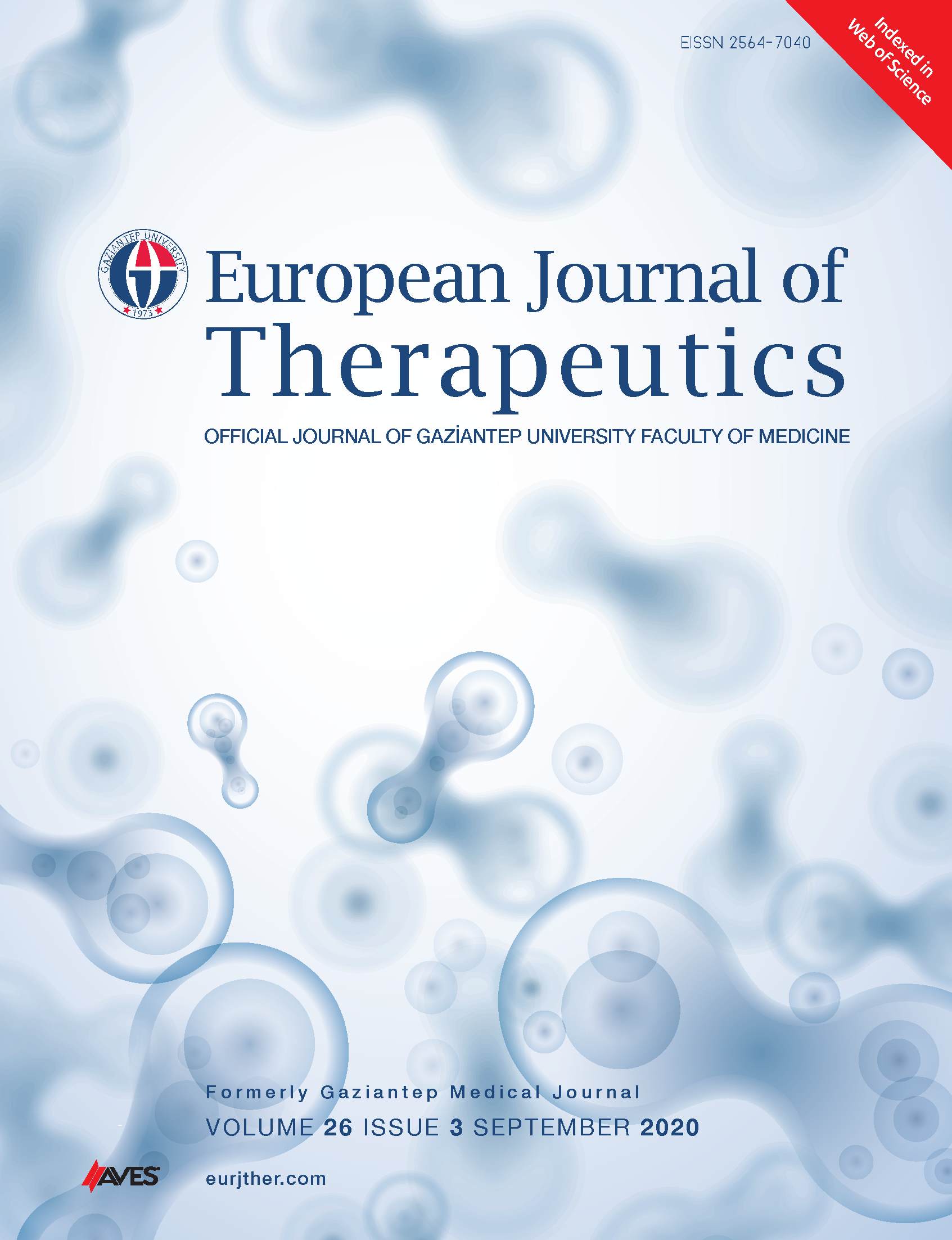Investigation of Bacterial Presence in Cerebrospinal Fluid by Bioimpedance Technique
DOI:
https://doi.org/10.5152/eurjther.2020.20136Keywords:
Bacteria, bioimpedance probe, cerebrospinal fluidAbstract
Objective: This study aimed to determine the presence of bacteria and their colony numbers in cerebrospinal fluid (CSF) by bioimpedance measurements at 50 kHz phase angle (PA) and 5 kHz impedance values.
Methods: We evaluated the performance of the 18 Gauge probe for detecting several types of bacteria in CSF ex-vivo. We equally monitored the electrical differentiation between colony numbers. A quantity of 200 µl sterile CSF was used as the standard in each experiment and was inoculated with 1, 2, 5, and 10 colonies of Coagulase-negative staphylococci, Streptococcus pneumoniae and Acinetobacter baumannii, separately.
Results: PA and impedance values of CSF samples were compared with each other concerning different colony numbers. It was observed that, varying numbers of colony strains of Acinetobacter baumannii, Coagulase-negative staphylococci, and Streptococcus pneumoniae could be differentiated from sterile CSF using PA and impedance values. Only one colony of the A. baumannii strain could not be distinguished from sterile CSF due to its thin cell wall composition.
Conclusion: The bioimpedance probe was time-saving and could detect the presence of bacteria in CSF samples correctly. Moreover, the probe can be used in the rapid detection of bacteria in CSF during real-time examinations.
Metrics
References
Benninger F, Steiner I. CSF in acute and chronic infectious diseases. Handb Clin Neurol 2017: 187-206.
Lukaski HC. Biological indexes considered in the derivation of the bioelectrical impedance analysis Am J Clin Nutr 1996; 64: 397S-404S.
Kalvøy H, Frich L, Grimnes S, Martinsen ØG, Hol PK, Stubhaug A. Impedance-based tissue discrimination for needle guidance Physiol Meas 2009; 30: 129-40.
Trebbels D, Fellhauer F, Jugl M, Haimerl G, Min M, Zengerle R. Online Tissue Discrimination for Transcutaneous Needle Guidance Applications Using Broadband Impedance Spectroscopy. IEEE Trans Biomed Eng 2012; 59: 494-503.
Kalvøy H, Sauter AR. Detection of intraneural needle-placement with multiple frequency bioimpedance monitoring: a novel method. J Clin Monit Comput 2016; 30: 185-92.
Mishra V, Schned AR, Hartov A, Heaney JA, Seigne J, Halter RJ. Electrical property sensing biopsy needle for prostate cancer detection. Prostate 2013; 73: 1603-13.
Kari J, Annala K, Annus P, Seppä VP, Kronström K. A thin needle with bio-impedance measuring probe: tissue recognition performance assessed in in vivo animal study. Injeq Oy Ltd., Tech Rep 2015.
Released IC, IBM SPSS Statistics for Windows, Version 23.0. 2013, IBM Corp.: Armonk, NY.
Vaneechoutte M, Dijkshoorn L, Nemec A, Kämpfer P, Wauters G. Acinetobacter, Chryseobacterium, Moraxella, and other nonfermentative Gram-negative rods. in Manual of Clinical Microbiology, 10th Edition. American Society of Microbiology, 2011: 714-38.
Zhou X, Li Y. Supragingival Microbes. in Atlas of Oral Microbiology, Academic Press: Oxford, 2015: 41-65.
Gisch N, Peters K, Zähringer U, Vollmer W. The Pneumococcal Cell Wall. in Streptococcus Pneumoniae, J. Brown, S. Hammerschmidt, and C. Orihuela, Editors. Academic Press: Amsterdam, 2015: 145-67.
Parija SC. Textbook of Microbiology and Immunology, 2/e. Elsevier India, 2012.
Van der AW, Minor M, Norde W, Zehnder AJB, Lyklema J. Conductivity and Dielectric Dispersion of Gram-Positive Bacterial Cells. J Colloid Interface Sci 1997; 186: 71-9.
Yang L. Electrical impedance spectroscopy for detection of bacterial cells in suspensions using interdigitated microelectrodes. Talanta 2008; 74: 1621-9. ,
Halonen S, Annala K, Kari J, Jokinen S, Lumme A, Kronstrom K, et al. Detection of spine structures with Bioimpedance Probe (BIP) Needle in clinical lumbar punctures. J Clin Monit Comput 2017; 31:1065-72.
Halonen S, Kankaanpaa E, Kari J, Parmanne P, Relas H, Kronstrom K, et al. Synovial fluid detection in intra-articular injections using a bioimpedance probe (BIP) needle-a clinical study. Clin Rheumatol 2017; 36: 1349-55.
Chen Q, Wang D, Cai G, Xiong Y, Li Y, Wang M, et al. Fast and sensitive detection of foodborne pathogen using electrochemical impedance analysis, urease catalysis and microfluidics. Biosens Bioelectron 2016; 86: 770-6.
Ward AC, NP Tucker, and P Connolly. Development of a diagnostic device to detect different Pseudomonas aeruginosa phenotypes in medically relevant contexts. Conf Proc IEEE Eng Med Biol Soc 2014; 2014: 2757-60.
Pehlivanoğlu F, Şengöz G. Microorganisms Isolated from Cerebrospinal Fluid and their Antibiotic Resistance. ANKEM Derg 2011; 25:1-5.
Norman K, Stobaus N, Zocher D, Bosy-Westphal A, Szramek A, Scheufele R, et al. Cutoff percentiles of bioelectrical phase angle predict functionality, quality of life, and mortality in patients with cancer. Am J Clin Nutr 2010; 92: 612-9.
Downloads
Published
How to Cite
Issue
Section
License
Copyright (c) 2023 European Journal of Therapeutics

This work is licensed under a Creative Commons Attribution-NonCommercial 4.0 International License.
The content of this journal is licensed under a Creative Commons Attribution-NonCommercial 4.0 International License.


















